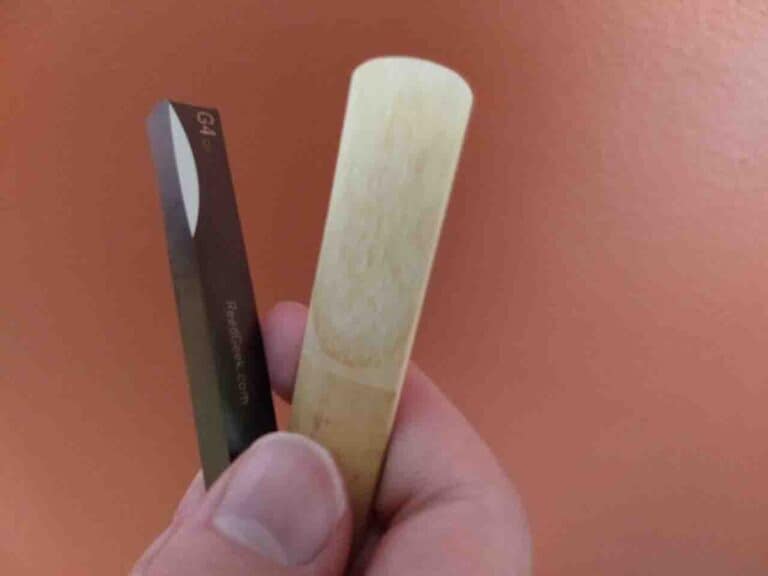How Often Should You Clean Your Saxophone?
Maintenance of an instrument is one of the most important aspects of owning and playing one. If you’re wondering how often you should be cleaning your saxophone and how to go about it, you’re in the right place.
You should clean your saxophone out with a swab at least once per day, immediately after you finish practicing. The mouthpiece should be cleaned once per month with lukewarm water and soap, and you should use a soft polish cloth on the body of the saxophone about once per week or as needed.
Swabbing
As mentioned above, I recommend swabbing all parts of your saxophone, including the neck and mouthpiece, at least once per day. Ideally, this should be immediately after you practice.
If you don’t practice every day, you probably don’t need to swab your instrument every day. Just swab it on the days you practice, immediately after practicing. If you practice multiple times per day, you should probably swab it after every practice session if you can.
Basically, swabbing is the sort of thing that you do after every time that you play your instrument, no matter how briefly you were playing it for. I would set the minimum as once per day if you practice multiple times per day and don’t have the time to swab it after each practice session.
You’ll need a silk swab attached to a string with a weight at the end. You can find one here.
To swab your saxophone:
- Drop the weight of the swab into the top (where the neck normally goes) of the saxophone and allow it to fall to the bottom of the bell.
- Rotate the saxophone so that weight falls out the end of the bell.
- Pull the string so that the swab goes through the entire instrument.
You should also go through this process for the neck and the mouthpiece. These parts of the instrument are much easier to swab than the body, as you won’t need to rotate a heavy object. Otherwise, just go through the same process.
In general, it is more important to keep the neck and mouthpiece clean than it is to keep the body clean. The body can air out, so neglecting to clean it may not cause a buildup of saliva the same way that neglecting to clean the neck or mouthpiece might.
If you have time, however, I do not recommend skipping out on swabbing the body. In fact, it may be worthwhile to swab the whole saxophone multiple times if you have the time to do so.
Washing the mouthpiece
You should wash your mouthpiece about once per month with lukewarm water, soap, and a soft-bristle mouthpiece brush.
The mouthpiece is one of the most important parts of the saxophone to keep clean, because any kind of buildup can seriously hurt your sound. Swabbing it certainly helps, but it will also need a more thorough cleaning on a regular basis. No worries if you don’t have a mouthpiece brush; a small toothbrush should work just as well.
To clean your mouthpiece:
- Fill a small bowl with lukewarm soapy water.
- Place the mouthpiece inside the bowl to get it wet.
- Lift the mouthpiece out of the bowl.
- Use the brush to gently scrub both the inside and outside of the mouthpiece to remove all gunk and calcification.
Mouthpiece patches
Many people put a mouthpiece patch on their mouthpiece to protect against bite marks. In fact, you should probably be doing this if you do not already.
If you aren’t familiar with mouthpiece patches, there are basically two kinds that you can get. These ones are smaller, and your upper teeth will still feel as if they are on the hard material of the mouthpiece. These ones are larger and more cushioned, in case you don’t like the feel of the mouthpiece under your teeth.
You should remove any mouthpiece patch that you use before cleaning your mouthpiece. This allows you to clean underneath the patch as well.
What NOT to do:
Do not use warm, hot, or cold water on ebonite (hard rubber) mouthpieces
Heat can cause the mouthpiece to discolor. Cold water is no better, however, which is why I recommend water that is lukewarm. It should be at about room temperature.
If you have a metal mouthpiece, then it is fine to use warm or even hot water if you so desire. It shouldn’t be necessary, though.
Do not put the mouthpiece in vinegar
While vinegar is often effective for cleaning, in this case it will damage the finish of the mouthpiece. Stick to soap and water.
Do not forget to put a mouthpiece patch on
Make sure that you are well stocked on mouthpiece patches, and don’t forget to put one on your mouthpiece after you finish cleaning it. You don’t want to leave bite marks in your mouthpiece the next time you play it.
Personally, I use one of the thicker cushioned patches with a smaller one on top of it. I find this helps my sound and lasts longer.
Polishing the saxophone
Polishing your saxophone will make sure that it stays nice and shiny and does not tarnish. Oils from our skin can speed up the tarnishing process, so polishing the saxophone simply wipes away the oils.
All you’ll need for this is a soft microfiber polish cloth. If you don’t already have one, you can find a nice one here.
To polish your saxophone:
Wipe down the entire outer surface with a polish cloth. Be especially gentle on the tops of the keys and rods. Do not wipe the surface of the pads.
There isn’t really much to polishing. Do this about once per week or so.
What NOT to do:
Do not use any kind of chemical on your saxophone to polish it.
Most of these chemicals will damage the instrument in some way.
If you have a silver saxophone, do not use silver polish.
Silver polish will effectively remove tarnish, but it will do so by stripping away a small layer of silver. Using it often enough will eventually strip away all the silver. Speaking of which…
Cleaning tarnish
The above cleaning procedures are the only ones which I would advise doing on a regular basis. Cleaning tarnish is something that you only really need to do when you can see it on your instrument.
If your saxophone does become tarnished, the best way to clean it off is with a tarnish cloth, which you can find here.
Wipe the tarnished areas with a tarnish cloth the same way that you would with a polish cloth. This will effectively remove the tarnish.
Tarnish is most common for silver instruments, but it can happen even with brass saxophones. It isn’t harmful to the instrument, but even so it may be best to remove it. Again, be especially gentle on the rods and the tops of the keys when using a tarnish cloth on them.
Rust
Saxophones do not rust. If you believe that you see rust on your saxophone, it is most likely tarnish instead. It can be cleaned off by wiping the tarnished areas with a tarnish cloth.
Sometimes tarnish is misidentified as rust, which is why I bother to include this point here. In any case, the solution is the same.
Pads
You should clean the pads whenever they begin to stick. Otherwise, pads do not need any particular maintenance, other than ensuring that you don’t put anything on them which causes damage.
Oils and residues in our skin, for instance, can cause harm to the pads. I also wouldn’t touch them with anything else (certainly don’t use dollar bills!) other than the pad paper which is typically used to clean and powder them. Speaking of which…
Cleaning the pads
You’ll need some pad cleaning paper, which you can find here. It will also be helpful to have some powder paper, which prevents pads from sticking in the future.
Place a piece of cleaning paper underneath the sticky pad. Gently press down on the key, and slowly pull the cleaning paper out from underneath it. This will remove any residue or oil which causes the pad to stick.
After using the cleaning paper to unstick your pad, you can make sure that it does not stick in the future by using powder paper. The process of doing this is the exact same; put the paper underneath the key, gently press the key down, and slowly pull the paper from underneath it.
The key here is to be gentle. If you press the key down and pull the paper out with too much force, the friction can damage the pad. Remember that the pads are just leather; they can get torn easily.
Conclusion
These are pretty much all of the cleaning procedures which you’ll need to use on your saxophone on a regular basis. As you can see, how often you should clean your saxophone depends on which cleaning process you are using, all of which have their proper time and place.
In short, what you need to do on a regular basis is:
- Swab out your saxophone, neck and mouthpiece at least once every time after you play.
- Wash the mouthpiece with lukewarm soapy water once per month, making sure to replace the mouthpiece patch.
- Use a polish cloth on your saxophone about once per week or so.
I hope this article has helped you learn to better maintain your saxophone.






One Comment